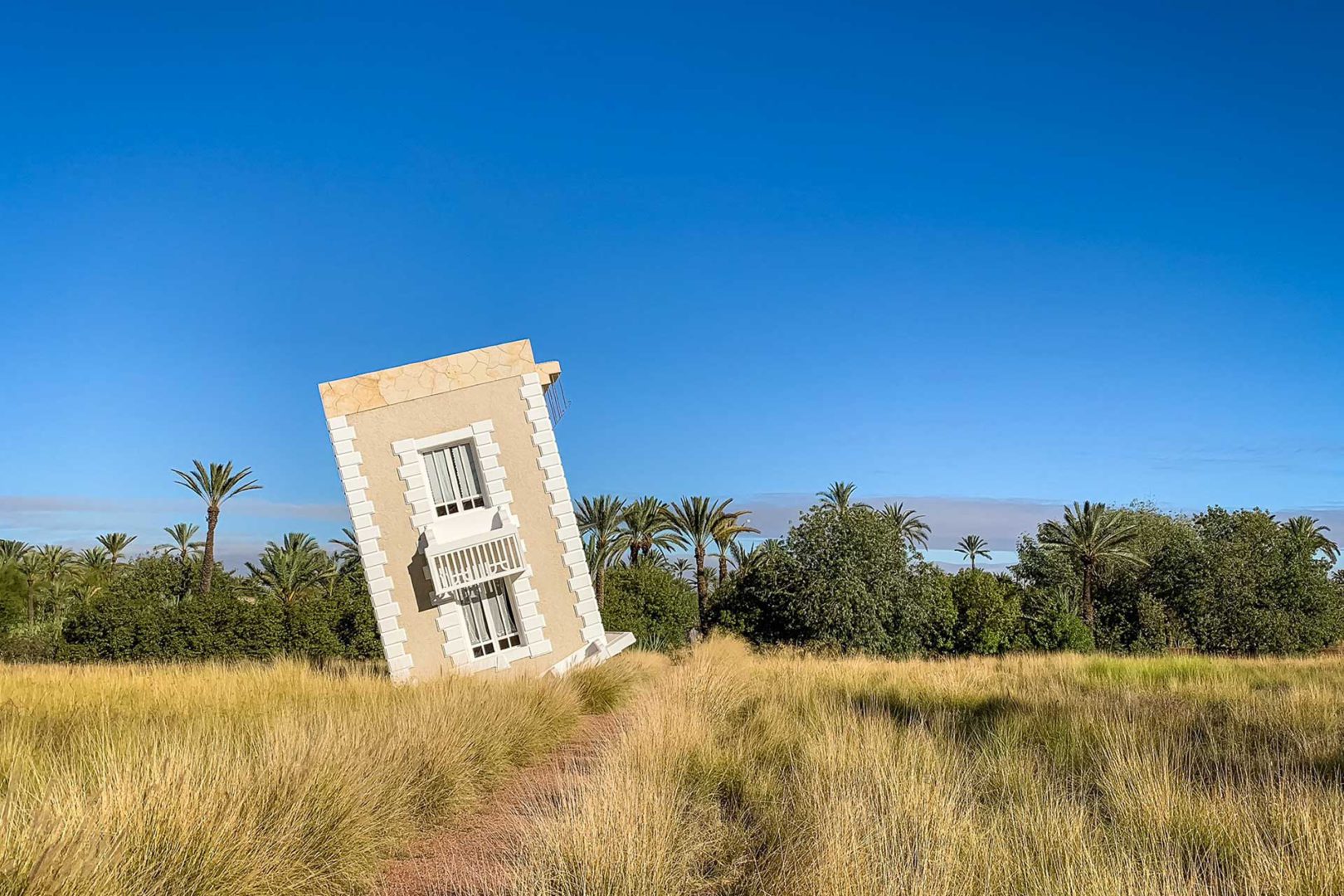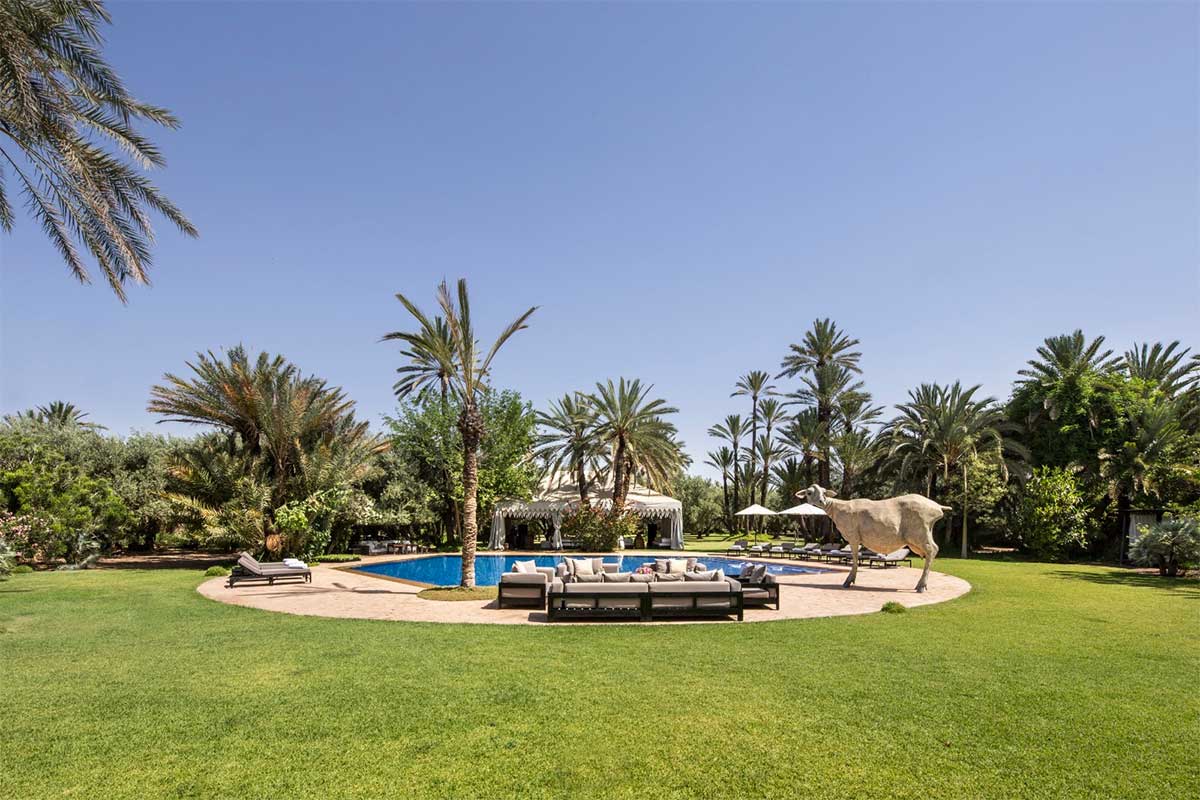First a family home, then the headquarters of a humanitarian foundation, a meditation retreat, an artists’ residence, and now a guesthouse
Dar El Sadaka, Marrakech
Dar El Sadaka, Marrakech is a destination whose purpose has evolved over the decades. The estate was founded as a family home before becoming the headquarters of a humanitarian foundation. Later it morphed into a meditation retreat and then an artists’ residence before leveling off at where it stands today: a private villa available for exclusive takeovers, moments from the city streets of Marrakech.
The owner and gatekeeper of Dar El Sadaka, Marrakech is Jean-François Fourtou, a French visual artist who leads with sculptures of animals. Now, the property is a hybrid gallery-villa. «It is an art installation itself, but one you can live in», says Fourtou.
The property has been in his family for a quarter of a century. Its history began with his father and his friend, who bought the grounds with little knowledge of Moroccan legislation surrounding land ownership and development in the 1990s. «It was complicated. After purchasing the land, my father realised that he couldn’t build a house and that he only had the right to restore the ruins. This is where they built Dar El Sadaka, Marrakech».
Lampoon review: city streets to country living
For Fourtou – a city resident and practising artist – countryside living was not the intent. As a graduate of the Superior National School of Fine art in Paris, his connection with the Marrakech property was familial. «In 1999, my family finished the first restoration. When I came to Dar El Sadaka, Marrakech that Christmas, I had been living in Spain, and I was about to go to live in New York for a few years. I decided to spend the winter in Marrakech with my family and help my father around the house».
«Due to the construction, there was a lot to do, and I took charge of managing the house. I had been used to living in cities; I had never chosen to live in the countryside before. I was working on my art, but the house started to take up my energy. When I left for New York, I was still in charge of the house, but it was complicated with the time difference. Little by little, I left my life in New York and left my studio in Madrid and brought those elements to Marrakech».
«That’s when I started to give Dar El Sadaka everything I had. I had doubts at the beginning. This place was sucking my energy, time and money. It was like having a baby who needs constant attention. But when I decided to live here, it gave me back everything I had given to it. Everyone who comes here says that it is an experience for them, sometimes a spiritual one. From the beginning, I developed a connection with nature; this place changed me».
The expansion of the property – the attention to craftspeople and traditions
At first, the property was a dot on the Moroccan landscape; over time, it expanded, taking up real estate that would finally be walled in at 11 hectares. «In the beginning, we were in the countryside. We started to buy land in front and behind the property. We grew outwards with the property in the middle. Finally, we built the walls around it».
The result is a three-part property. The key ingredient is Dar El Sadaka, Marrakech the main house; what was once the shell of a traditional Moroccan homestead is now a combination of conventional aesthetics and modern design. There is an area to the front of the house where the sculptures and installations lie. An additional house has been built, too.
It is the newfound family hub: ‘The Beehouse’. Expectedly, the design and contents are related to bees and beehives. About creating the various spaces, Fourtou explains, «It was essential for us to work with local craftspeople. When you live in the city, you have your studio, but you are not connected to humans. When you live in the countryside, you are surrounded by craftspeople and traditions; you can experiment with scale because you have the space».
Dar El Sadaka, Marrakech – the marriage of two creative minds
Severing ties with city living and committing to Dar El Sadaka was a chance to showcase his work in a novel setting, explains Fourtou. «I decided to put my studio on the property. For me, it was an opportunity to show my artwork. During the past 20 years, I have created a lot of installations on the grounds which are reflections of my career». The result is a destination that fuses elevated accommodation with art installations spread across 25 acres of gardens and groves.
The villa itself consists of nine themed bedrooms – the Dog Suite, the Tortoises Suite, the Geese Suite – sleeping up to twenty guests at one given time. Exclusive takeovers are the sole way to experience Dar El Sadaka, and the minimum stay is three nights. «Everything is an experience here», says Fourtou. The property is a result of the artistic collaboration between Fourtou and Philippe Forrestier. «Sometimes in life, you find connections like ours; complementary artistic collaborations».
The property that exists today is the fruit of their creative explorations. «Philippe was working in fashion in Italy. Then he decided to work with light sculptures and installations, and he came to Morocco. We met this way. We started to work together, but we have our own approaches; Dar El Sadaka has been a combination of us working together. It is not easy to find two creatives who work so well together».
The design approach at Dar El Sadaka
As for their approach, Fourtou says, «We designed each room as if it was an installation around a sculpture of an animal». Expectedly, Fourtou’s animal forms are seen at length across the property. «My sculptures are not the typical types of sculptures that you will put on a plinth. You need to live with them, and that’s what I wanted to see here Dar El Sadaka. People like this element of Dar El Sadaka; everyone feels a strong relationship with our work because it’s close to childhood and nature – everybody can relate to it», says Fourtou.
When accessing the outdoor dining space, guests pass under a giraffe’s legs en route. «We have the impression that the giraffe is going to eat with us». In the living room, orangutans swing from the ceiling, giving off the impression that they are trying to communicate with us, says Fourtou. Aside from sculptures, life-size sets which play with proportion and illusion invite guests «to become a child again».
‘The Giant’s House’ at Dar El Sadaka
In ‘The Giant’s House’, oversized items take precedence. «It is inspired by the memories that I had when I was in my grandmother’s house. You have to climb up on huge furniture in the same way that you had to as a child. You experience sensations that you lost after childhood». For the artist, one experience stands apart from the rest: the upside-down house.
«When you get inside, you lose control of yourself because it is on an incline. It is as if you are seasick because you lose the sense of gravity. It is like motion sickness. I love to tease like this – particularly adults. Kids are used to these weird worlds. For adults, it is an opportunity to act like children again. I love to provoke that playfulness». This particular exhibit is dedicated to Fourtou’s grandfather. «He inspired me when I was a kid. The house honours him. It is called ‘Falling by the Sky’ as if it was a response from my grandfather».
Dining at Dar El Sadaka, Marrakech
These abstract experiences extend to dining, too. «When people first arrive, they start booking restaurants outside of the villa, but they end up cancelling it after they have finished exploring the property because when you are here, you want to experience what that is on offer». Guests can avail of the opportunity to enjoy dinner in ‘The Giant’s House’, or dine under a tree illuminated by 1,000 candles. For those who are astronomically inclined, there is the night dinner, where an astronomer reads the sky.
The food supports the theme of the dinners; this is one of Dar El Sadaka’s focuses. «Our chef, Madame Hasna, is experimental. She and Philippe speak about food. They work on colour, smell and texture. We are constantly experimenting», says Fourtou. Harvesting produce from its on-site vegetable garden is of priority. With a dedication to sustainable farming, natural ingredients and eco-friendly practices, the goal is to primarily grow their menu on the property.
Conserves and jams are homemade; honey is produced on the grounds. The olive oil is sourced from the groves; vegetables and herbs are harvested from the garden. The meat and fish are brought in, having been procured from local fishers and independent butchers, respectively. «We serve what we have grown on the land. We want to be as close to nature as possible and to be respectful of the land», says Fourtou. For chef Madame Hasna, authenticity and creativity guide the menu that caters, on request, to dietary requirements and preferences.
The services available at Dar El Sadaka
In addition to the dedicated chef who caters for every meal – guests are not permitted to use the professional kitchen day or night – Dar El Sadaka, Marrackech is complete with a team of multilingual private drivers, housekeeping, concierge and a Guest Experience Manager. «We are creating a family here. These are people who have been working with us from the beginning. We have relationships with these people, and when people come to stay, they feel it», says Fourtou.
On-site, there is a gym and hammam for guest use. A spa treatment room welcomes guests, and beauty treatments and massages are available on request. Outdoors, there is a heated swimming pool, tennis courts, a ping-pong table, a boules pitch and swings. Wandering the lot is encouraged with a garden maze, a sculpture park, vegetable gardens and groves to explore. While Dar El Sadaka is suited to adults, children are welcome but supervision is recommended.
Dar El Sadaka: ‘the house of the seeker’
As for its name, Dar El Sadaka, Fourtou shares that its meaning is two-fold, «My father and his friend chose it because in Arabic it means the ‘house of friendship’. I didn’t like this definition because my father and his friends’ relationship broke down. But, as I was doing meditation and yoga, I realized that in the Sanskrit alphabet, Dar El Sadaka means ‘the house of the seeker’. I thought that definition was appropriate for the house and the people who come here. For me, it was then that it started to make sense».
When asked as to what the future holds for Dar El Sadaka, Fourtou attests that in line with Dar El Sadaka’s meaning, the property will never be ‘finished’ per se. «This is the house of the one who seeks; we are always looking for ways to improve, and we feel that energy of creativity runs through everything we do».
Dar El Sadaka, Marrakech
Rue de Bab Aylan, Marrakech, Morocco
A private villa rented out for exclusive use on a year-round basis by French visual artist Jean-François Fourtou and interior designer Philippe Forrestier located a short drive from the centre of Marrakech.




















